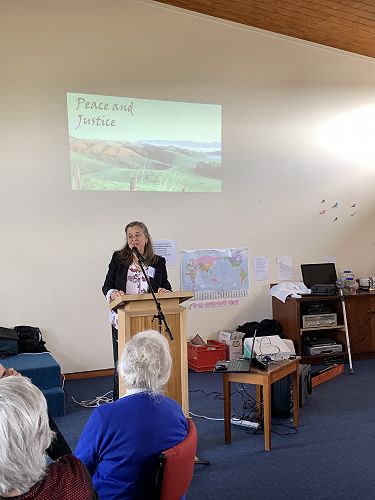
Diocesan Training Day: Part 2
The second part of our report from the Training Day on Saturday 13 February in Balclutha.
Link to Part 1
Conflict Management Style
The second part of the day included some input from Rev'd John Graveston (Diocesan Child, Youth and Family Educator) and Anne Gover.
John and Anne started their session by talking broadly about conflict and how conflict is normal and to be expected in our lives, so it is important to be prepared for it when it occurs. It is also good to consider if any conflict we are experiencing is a negative situation or a positive situation, as conflicts can have both effects. One way to be prepared for conflicts is to know how you react to the situation. In other words, what is your conflict style? The groups were then handed out an individual questionnaire that would help show them what conflict management style they are. (You can find that questionnaire here).
After completing the questionnaire, people are given one of the five animals listed as a preferred conflict management style. Sometimes scores can come out even: In those cases, both styles can be your dominant ones. The animal options are as follows: The Competing Shark, The Avoiding Turtle, The Accommodating Teddy Bear, The compromising Fox, The Collaborating Owl.
John and Anne then went on to explain what the different animals meant and the pros and cons of each style (this can be found attached to the questionnaire linked above). It is important to know the strength and weaknesses of your style so that you might be able to come to a win-win situation.
John and Anne then carried on to talk about different stages of a conflict:
1. Recognition – where you recognise when you are about to encounter a difficult situation.
2. Decision – Are you going to engage in this conflict or leave it? Do I have the self-awareness to engage in a positive way?
3. To Engage - Take three deep breaths, pray. Do our ‘goals’ conflict? Is there something I want, that opposes [directly or indirectly] the other person’s goals?
4. Managing Conflict - Know and understand priorities and the relative importance of the relationship in question. Choose an appropriate strategy to manage the conflict.
5. Develop a solution together - Aim for a win/win approach. Focus on creating a better balance of everyone’s needs. Discuss solutions and next steps. Reach an agreement about what will happen next – immediate or long-term.
John and Anne helped those at the workshop to think about how they deal with conflict and if there were any other ways that they could do so that would help next time they were in conflict.

Mediating Dangerously
Michael’s session took us into legal terms and definitions that are helpful for us in the church to know about if a conflict escalates to needing outside help. We heard about different types of disputes (criminal, and civil) and about how resolutions can be used in civil disputes. The different resolutions talked about were litigation, arbitration, mediation, and negotiation. It was highlighted that we would not talk about litigation or arbitration, as if you are at that stage these conversations need to be in the hands of the professional (like a lawyer or other specialist). Michael then went into more details about mediation and negotiation.
Mediation is a process in which a neutral advisor is asked to help the two conflicting parties talking in the hope that they will engage in a discussion, to help evaluative each party's strength and weakness and they can also put a bit of pressure on to find a solution. Michael stressed that mediation should be consensual and confidential (within safe limits). Michael also talked about Negotiation and defined it as
"A process by which two parties with differences that they need to resolve, try to reach an agreement through exploring options and exchanging offers – and an agreement.”
After discussing the different definitions, we watched a video of Bishop Anthony and heard about his story of pain and sacrifice when a community came into conflict. It is a very powerful story and highly recommended.
The differences between all of the above are useful for us to understand what is available if the conflict cannot be solved between the parties internally but needs external help for a solution to be found.

Gallery






